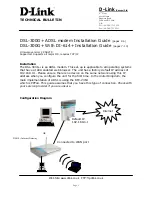
Prestige 861 VDSL Modem
5-2
VDSL Commands
Table 5-2 PVC Default Values
VDSL PARAMETER
DEFAULT VALUE
Encapsulation Mode
LLCBridged (LLC Encapsulation for Bridged Protocols)
VPI/VCI for PVC 0
0/33
Traffic Class
UBR
Peak Cell Rate
262144
(100Mbps)
Cell Delay Variation Tolerance
1
5.4 Introduction
to
ATM
ATM (Asynchronous Transfer Mode) is a connection-oriented switching technology that uses fixed-size cells
to transmit data across a dedicated path (permanent virtual circuit (PVC)).
An ATM service contract is an agreement between the carrier and the subscriber to regulate the average rate
and fluctuations of data transmission over an ATM network. This agreement helps eliminate congestion,
which is important for transmission of real time data such as audio and video connections.
5.4.1 Quality of Service (QoS) Parameters
Peak Cell Rate (PCR) is the maximum rate at which the sender can send cells. This parameter may be lower
(but not higher) than the maximum line speed. 1 ATM cell is 53 bytes (424 bits), so a maximum speed of 832
Kbps gives a maximum PCR of 1962 cells/sec. This rate is not guaranteed because it is dependent on the line
speed.
Sustained Cell Rate (SCR) is the mean cell rate of each bursty (data flows followed by idle periods) traffic
source.
It specifies the maximum average rate at which cells can be sent over the virtual connection. SCR
may not be greater than the PCR.
Maximum Burst Size (MBS) is the maximum number of cells that can be sent at the PCR. After MBS is
reached, cell rates fall below SCR until cell rate averages to the SCR again. At this time, more cells (up to
the MBS) can be sent at the PCR again.
The following figure illustrates the relationship between PCR, SCR and MBS.
















































